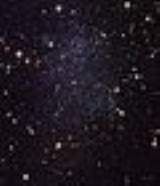
Sagittarius Dwarf Irregular Galaxy
Encyclopedia
The Sagittarius Dwarf Irregular Galaxy or SagDIG is a dwarf galaxy
in the constellation
of Sagittarius
. It lies about 3.4 million light-year
s away. SagDIG should not be confused with the Sagittarius Dwarf Elliptical Galaxy
or SagDEG, a satellite galaxy
of the Milky Way
. It was discovered by Cesarsky et al. on a photographic plate
taken for the ESO (B) Atlas on June 13, 1977 using the ESO
1 meter Schmidt telescope.
The SagDIG is the most remote object from the barycenter
thought to be a member of the Local Group
. It is only slightly outside the zero-velocity surface
of the Local Group.
SagDIG is a much more luminous galaxy than Aquarius Dwarf
and it has been through a prolonged star formation (Momany et al. 2005). This has resulted in it containing a rich intermediate-age population of stars. Twenty-seven candidate carbon stars have been identified inside SagDIG. Analysis shows that the underlying stellar population of SagDIG is metal-poor (at least [Fe/H] ≤ −1.3). Further, the population is young, with the most likely average age between 4 and 8 Gyr for the dominant population.
Dwarf galaxy
A dwarf galaxy is a small galaxy composed of up to several billion stars, a small number compared to our own Milky Way's 200-400 billion stars...
in the constellation
Constellation
In modern astronomy, a constellation is an internationally defined area of the celestial sphere. These areas are grouped around asterisms, patterns formed by prominent stars within apparent proximity to one another on Earth's night sky....
of Sagittarius
Sagittarius (constellation)
Sagittarius is a constellation of the zodiac, the one containing the galactic center. Its name is Latin for the archer, and its symbol is , a stylized arrow. Sagittarius is commonly represented as a centaur drawing a bow...
. It lies about 3.4 million light-year
Light-year
A light-year, also light year or lightyear is a unit of length, equal to just under 10 trillion kilometres...
s away. SagDIG should not be confused with the Sagittarius Dwarf Elliptical Galaxy
Sagittarius Dwarf Elliptical Galaxy
The Sagittarius Dwarf Elliptical Galaxy is an elliptical loop-shaped satellite galaxy of the Milky Way Galaxy. It consists of four globular clusters, the main cluster being discovered in 1994...
or SagDEG, a satellite galaxy
Satellite galaxy
A satellite galaxy orbits a larger galaxy due to gravitational attraction. Although a galaxy is made of a large number of objects which are not connected to each other, it has a center of mass, which represents a weighted average of the positions of each component object...
of the Milky Way
Milky Way
The Milky Way is the galaxy that contains the Solar System. This name derives from its appearance as a dim un-resolved "milky" glowing band arching across the night sky...
. It was discovered by Cesarsky et al. on a photographic plate
Photographic plate
Photographic plates preceded photographic film as a means of photography. A light-sensitive emulsion of silver salts was applied to a glass plate. This form of photographic material largely faded from the consumer market in the early years of the 20th century, as more convenient and less fragile...
taken for the ESO (B) Atlas on June 13, 1977 using the ESO
European Southern Observatory
The European Southern Observatory is an intergovernmental research organisation for astronomy, supported by fifteen countries...
1 meter Schmidt telescope.
The SagDIG is the most remote object from the barycenter
Barycentric coordinates (astronomy)
In astronomy, barycentric coordinates are non-rotating coordinates with origin at the center of mass of two or more bodies.The barycenter is the point between two objects where they balance each other. For example, it is the center of mass where two or more celestial bodies orbit each other...
thought to be a member of the Local Group
Local Group
The Local Group is the group of galaxies that includes Earth's galaxy, the Milky Way. The group comprises more than 30 galaxies , with its gravitational center located somewhere between the Milky Way and the Andromeda Galaxy...
. It is only slightly outside the zero-velocity surface
Zero-velocity surface
The zero-velocity surface is a concept that relates to the N-body problem of gravity. The zero-velocity surface is particularly significant when working with weak gravitational interactions among orbiting bodies.-Galaxy clusters:...
of the Local Group.
SagDIG is a much more luminous galaxy than Aquarius Dwarf
Aquarius Dwarf
The Aquarius Dwarf galaxy is a dwarf galaxy and an irregular galaxy, that was first catalogued in 1959 by the DDO survey. Its most distinctive characteristic is that it is one of the few galaxies known to display a blueshift, as it is traveling towards the Milky Way at 137 km/s. Aquarius...
and it has been through a prolonged star formation (Momany et al. 2005). This has resulted in it containing a rich intermediate-age population of stars. Twenty-seven candidate carbon stars have been identified inside SagDIG. Analysis shows that the underlying stellar population of SagDIG is metal-poor (at least [Fe/H] ≤ −1.3). Further, the population is young, with the most likely average age between 4 and 8 Gyr for the dominant population.

